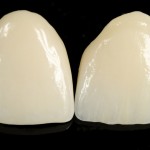
While laminate veneers were first used in the 1930s it was not until after enamel etching and improvements in bonding during the 1980s that porcelain veneers were introduced. The aim of this review was to assess the survival of feldspathic porcelain veneers.
The Cochrane Library, Medline, Embase and Web of Knowledge databases were searched. A number of dental journals were handsearched together with the reference lists of identified studies. Clinical trials registers, conference proceedings, and contacts with academic colleagues were used to identify unpublished data, abstracts, and other gray literature. Two authors independently screed the articles. At least some of the veneers in each study had to be in situ for 5 years.
- 11 studies met the criteria, with 6 cohort studies (2 retrospective, 4 prospective) contributing to a meta-analysis.
- Of the 6 studies, 5 provided 5-year survival estimates, with 3 also providing 10-year survival estimates
- The random-effects method calculated a 5-year pooled cumulative survival of 95.7% (95% CI: 92.9% to 98.4%)
- The 10-year summary estimates of survival ranged from 64% to 96% in the included studies. Owing to high levels of heterogeneity meta-analysis was not conducted.
The authors concluded
The summary estimated cumulative survival for feldspathic porcelain veneers was 95.7% (95% CI: 92.9% to 98.4%) at 5 years and ranged from 64% to 95% at 10 years across three studies. A post hoc meta- analysis indicated that the 10-year best estimate may approach 95.6% (95% CI: 93.8% to 97.5%). The high levels of statistical heterogeneity found may be related to both clinical and methodologic differences among the included studies. In particular, the partial bonding of porcelain veneers to reduced enamel may be associated with decreased estimated cumulative survival rates. Care should be taken by future researchers to ensure that tooth characteristics and censoring are well described, the precision of the calculated summary estimate is reported, survival definitions are clinically relevant, and clustered outcomes are correctly analyzed.
Comment
The authors note a previous systematic review of this topic by Kreulen et al in 1998 that reported an estimated survival rate at 3 years of 92% ( 95%CI; 90-94%). The review also includes a very detailed discussion of the sources of heterogeneity found in the studies.
Links
Layton DM, Clarke M, Walton TR. A systematic review and meta-analysis of the survival of feldspathic porcelain veneers over 5 and 10 years. Int J Prosthodont.2012 Nov-Dec;25(6):590-603. PubMed PMID: 23101039
Kreulen CM, Creugers NH, Meijering AC. Meta-analysis of anterior veneer restorations in clinical studies. J Dent. 1998 May;26(4):345-53. PubMed PMID:9611940.

Thanks for this Derek. I was intrigued to read in their abstract that they included only studies “with at least some of the veneers in situ for 5 years”. This raises the possibility that if there were studies showing veneers lasting less than 5 years that these would not go into the analysis. I wonder if they meant a follow up of 5 years…